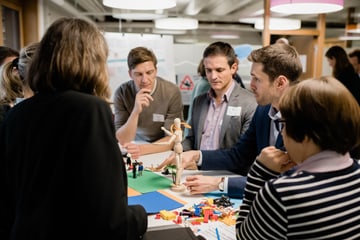The cornerstones of organisational transformation
Professionals from a variety of organisations, from the field of international cooperation and elsewhere, tell us about their path to innovation. Find here the key takeaways.

The origin of this blog article
At cinfo's 2019 Immersion Day "Shaping the organisation of the future", we asked 14 professionals why and how their organisations have taken the path of transformation. Their stories were told in different workshops on the topics of user-centric projects, new HR, digital tools and leadership.
Check out the 14 inspiring stories
The user is in the centre
Beneficiaries and their needs should always be at the centre of our work, especially in our branch. We are facing a climate and migration crisis – and if we do not find answers now, our society will face serious challenges. It is high time our organisations take an interest in innovation and user-centred approaches. We should remember that it is not about what we need, politically or institutionally; it is about what the beneficiaries need. Methods such as design thinking ensure that we do not lose sight of this objective.

Culture comes first
To work in a user-centric and innovative manner, an organisation must adapt its approach to human resources. Innovation can come from everywhere – from the field, from HQ, from management. To give employees the ability to innovate, you have to give them space, adapt structures, and foster trust and a spirit of entrepreneurship: it is all about culture. In a safe space, based on trust and the right to make mistakes, employees will feel empowered to try out new ways of working, in accordance with the principle of “safe enough to try”. They will also be more motivated and willing to share information, successes and failures with colleagues.
Technology cannot solve everything
Digital tools have become an important part of development and humanitarian projects, for example in monitoring their impact. They collect data and create algorithms that influence decision-making processes in projects. However, this growing reliance on new technologies faces a major challenge present in every organisation: behind every technical solution there is an often-underestimated human element. Innovation is not just about the tool; it is also about people’s commitment to organisational change. You may face resistance to the process of implementing digital transformation. Staff may sometimes be overloaded and unable to develop new skills or adapt their processes. Be sure to provide the necessary support to ease the digital transition.

The role of leaders
An essential prerequisite for an organisation to develop a culture of innovation is for its managers to fulfil their role of enabling and supporting innovation. Mistakes must be allowed and space for innovation has to be created. This can mean creating a physical space that encourages new ways of thinking about the problem to be solved, enough time in the weekly agenda or time dedicated to innovation in employees’ annual objectives. An innovative culture requires the willingness, support and commitment of the management, which has to relinquish power.


